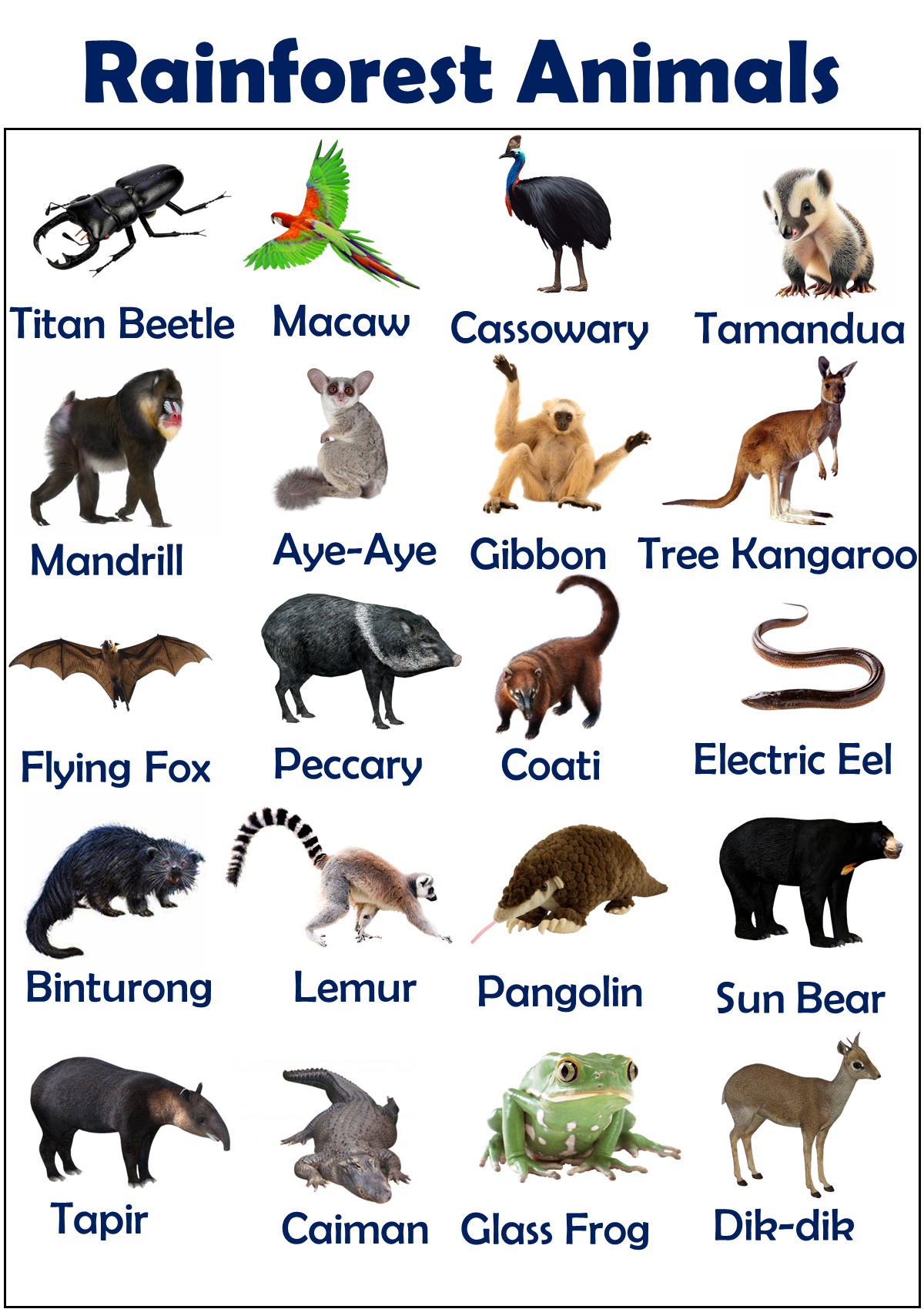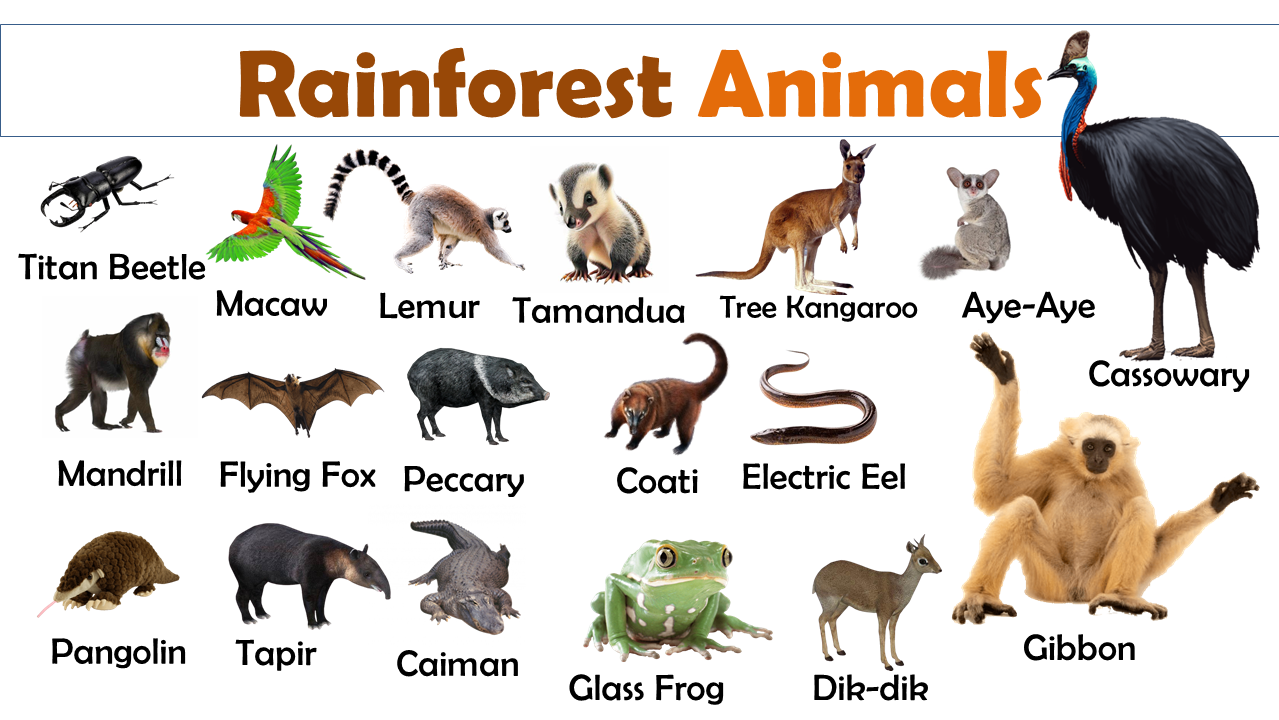Rainforests animals are like giant outdoor classrooms, full of colorful and mysterious animals. In this blog post, we’ll take a closer look at the creatures that call the rainforest their home. From swinging monkeys to silent butterflies, you’ll learn about their behaviors, habitats, and the important roles they play in the rainforest. This adventure will not only introduce you to some new and advanced English vocabulary words but also to some of the most interesting animals on our planet. Let’s discover the wonders of rainforest animals together!
What are Rainforest Animals?
Rainforests are vibrant ecosystems known for their biodiversity. These dense, warm, and wet forests are home to an astonishing variety of animals, many of which are uniquely adapted to the humid and shadowy environment of the forest floor and the brightly lit canopy.
List of Rainforest Animals
- Jaguar
- Harpy Eagle
- Sloth
- Orangutan
- Anaconda
- Poison Dart Frog
- Capybara
- Toco Toucan
- Spider Monkey
- Blue Morpho Butterfly
- Okapi
- Piranha
- Aye-Aye
- Cassowary
- Kinkajou
- Red-Eyed Tree Frog
- Tapir
- Hoatzin
- Electric Eel
- Agouti
- Howler Monkey
- Green Anaconda
- Ocelot
- Saola
- Coati
- Pink River Dolphin
- Uakari Monkey
- Sumatran Rhinoceros
- Caiman
- Gibbon
- Leafcutter Ant
- Emperor Tamarin
- Mandrill
- Peccary
- Flying Fox
- Bushmaster Snake
- Dik-dik
- Tree Kangaroo
- Sun Bear
- Golden Lion Tamarin
- Macaw
- Quetzal
- Boa Constrictor
- Horned Beetle
- Glass Frog
- Lemur
- Pit Viper
- Pangolin
- Fruit Bat
- Woolly Monkey
- Titan Beetle
- Spectacled Bear
- Binturong
- Motmot
- Leaf-Tailed Gecko
- Civet
- Dracula Ant
- King Colobus Monkey
- Viper
- Jaguarundi
- Tamandua
- Saki Monkey
- Tarsier
- Black Caiman
- Potoo
- Dwarf Caiman
- Bush Dog
- Golden Frog
- Woolly Opossum
- Vine Snake
Explore More Animal Vocab:

Rainforest Animals Vocabulary and Their Facts
1. Jaguar
The jaguar is the third-largest big cat in the world and the largest in the Americas. Known for its powerful build and deep chest, the jaguar thrives in the dense rainforest where it preys on a variety of animals, including deer and capybaras. Its beautifully rosetted fur helps it blend into the lush undergrowth, making it an adept ambush predator.
2. Harpy Eagle
The harpy eagle, one of the largest and most powerful eagles globally, resides at the top of the rainforest canopy. It preys primarily on medium-sized mammals like sloths and monkeys. With its sharp talons and keen eyesight, the harpy eagle is a formidable hunter, symbolizing the aerial dominance of the rainforest.
3. Sloth
Sloths are known for their slow movement and spending most of their life hanging upside down in the trees of the tropical rainforests. This unique behavior helps them conserve energy and avoid predators. Their diet mainly consists of leaves, which are low in nutrients and require a specialized slow metabolism to digest.
4. Orangutan
Native to the rainforests of Borneo and Sumatra, orangutans are highly intelligent primates known for their reddish-brown hair and strong arms. They spend most of their lives in trees and are critically endangered due to habitat destruction and illegal hunting. Orangutans have complex social structures and are known for using tools.
5. Anaconda
The green anaconda, one of the largest and most powerful snakes in the world, resides in the swamps and rivers of the Amazon rainforest. It is an excellent swimmer and can remain submerged for a long time before striking prey such as large rodents, deer, and even caimans.
6. Poison Dart Frog
These small, brightly colored frogs are famous for the potent toxin they secrete, which indigenous people have used to poison the tips of blow darts. Poison dart frogs are found in Central and South American rainforests, and their vivid coloration is a warning to predators about their toxicity.
7. Capybara
The capybara is the world’s largest rodent and is native to the rainforests of Central and South America. It lives in close proximity to bodies of water and is an excellent swimmer. Capybaras are social animals, often found in groups, and play a crucial role in the ecosystem as prey for larger predators.
8. Toco Toucan
Known for its striking large bill, the toco toucan is a vibrant bird found throughout the Amazon rainforest. Its bill is not only a feeding tool but also a thermal regulation system. Toucans are social creatures, often seen in small flocks in the canopy, feeding on fruits, insects, and sometimes young birds.
9. Spider Monkey
Spider monkeys are agile primates with long limbs and tails, making them excellent climbers and swingers. They inhabit the upper layers of the rainforest and play a critical role in seed dispersal, which is vital for the health of their ecosystem. They are among the largest New World monkeys and are threatened by habitat loss.
10. Blue Morpho Butterfly
The blue morpho butterfly is renowned for its vibrant blue wings, which are used to startle predators and attract mates. They inhabit the tropical forests of Latin America and are seen mostly during the day feeding on the juices of rotting fruits.
11. Okapi
Often called the “forest giraffe,” the okapi is a reclusive animal found in the dense rainforests of the Democratic Republic of the Congo. Despite its zebra-like stripes, it is most closely related to the giraffe. The okapi’s diet consists mainly of leaves and fruit, and it uses its long tongue to reach vegetation.
12. Piranha
Piranhas are infamous for their sharp teeth and a reputed ability to devour large animals quickly. They primarily feed on fish, but also eat crustaceans, and occasionally larger animals and seeds. Piranhas are an essential part of the aquatic food chain, helping scavenge and keep rivers clean.
13. Aye-Aye
The aye-aye is a lemur native to Madagascar, not a typical rainforest animal but still found in rainforest habitats. It is known for its unique method of finding food: tapping on trees to locate insects, then gnawing holes in the wood and using its long middle finger to pull the insects out.
14. Cassowary
Cassowaries are among the largest birds in the world and are native to the rainforests of New Guinea and northeastern Australia. They are known for their striking blue and black plumage and helmet-like casques on their heads. Cassowaries are solitary and can be very aggressive, especially when threatened.
15.Kinkajou
The kinkajou, also known as the honey bear, is a small mammal native to the rainforests of Central and South America. It has a prehensile tail and spends most of its life in the trees. Kinkajous are nocturnal and primarily eat fruits, but they also enjoy honey and insects.
16. Red-Eyed Tree Frog
Famous for its bulging red eyes, the red-eyed tree frog is a small, colorful frog native to the rainforests of Central America. Its vivid colors, which include a bright green body and blue and yellow striped sides, help it blend in with the foliage and startle predators.
17. Tapir
Tapirs are large browsing mammals that inhabit the jungles of Central and South America and Southeast Asia. They play a critical role in their ecosystems as seed dispersers. Tapirs are characterized by their prehensile snouts that help them grab branches and leaves.
18. Hoatzin
Often called the “stinkbird,” the hoatzin is a tropical bird found in the Amazon Rainforest. It is known for its unique digestive system that ferments vegetation, similar to how cows digest their food, which causes it to emit a manure-like odor.
19. Electric Eel
Electric eels are not true eels but a type of knife fish. They can generate an electric charge powerful enough to stun prey and deter predators, making them one of the Amazon’s most electrifying inhabitants. They rely on this ability since they have poor eyesight.
20. Agouti
Agoutis are rodent species, widespread in the rainforests of Central and South America. They play a crucial role in their ecosystems by dispersing seeds. Agoutis have sharp teeth and can crack nuts that other animals can’t, such as the Brazil nut, contributing to forest regeneration.
21. Howler Monkey
Known for their loud howls, which can be heard up to three miles away in the dense forest, howler monkeys are the largest of the New World monkeys. They live in groups and are folivorous, primarily eating a diet of leaves.
22. Green Anaconda
A cousin of the anaconda, the green anaconda is the heaviest snake in the world. It resides in the South American rainforest and waterways, where it uses its massive strength to constrict and drown its prey, which includes fish, birds, and even large mammals.
23. Ocelot
The ocelot is a medium-sized wild cat known for its strikingly marked fur. It roams the rainforests of Central and South America and is adept at climbing and swimming. Ocelots are solitary animals, primarily active during the night.
24. Saola
Known as the “Asian unicorn,” saolas are critically endangered and were only discovered in 1992 in the rainforests of Vietnam and Laos. They are known for their distinctive long horns and are very elusive, living in remote areas of dense forest.
25. Coati
Coatis, related to raccoons, are also known as coatimundis. They are omnivores and inhabit the forests of South America. They have flexible snouts and long tails that are often used for balance and signaling within their social groups.
26. Pink River Dolphin
The pink river dolphin or boto is found in the Amazon River and its tributaries. It is known for its distinctive pink coloration and high intelligence. Unlike most other dolphins, it has a flexible neck and can maneuver in the flooded forest with ease.
27. Uakari Monkey
Uakaris are distinctive for their short tails and bright red faces. They live in the Amazon rainforest, in groups, and feed primarily on fruits. Their red face is thought to be an indicator of health to potential mates.
28. Sumatran Rhinoceros
The Sumatran rhinoceros is one of the most endangered mammals in the world, found in isolated pockets of the Asian rainforest. It is the smallest of the living rhinoceroses and has two horns, which unfortunately make it a target for poachers.
29. Caiman
Caimans are close relatives of alligators and crocodiles, found in Central and South American wetlands and rivers. They are smaller than their relatives but play a similar ecological role as apex predators in their habitats.
30. Gibbon
Gibbons are small apes known for their incredible agility and the songs they sing to communicate with each other. They live in the rainforests of Southeast Asia and spend most of their time in the canopy, rarely coming down to the ground.
